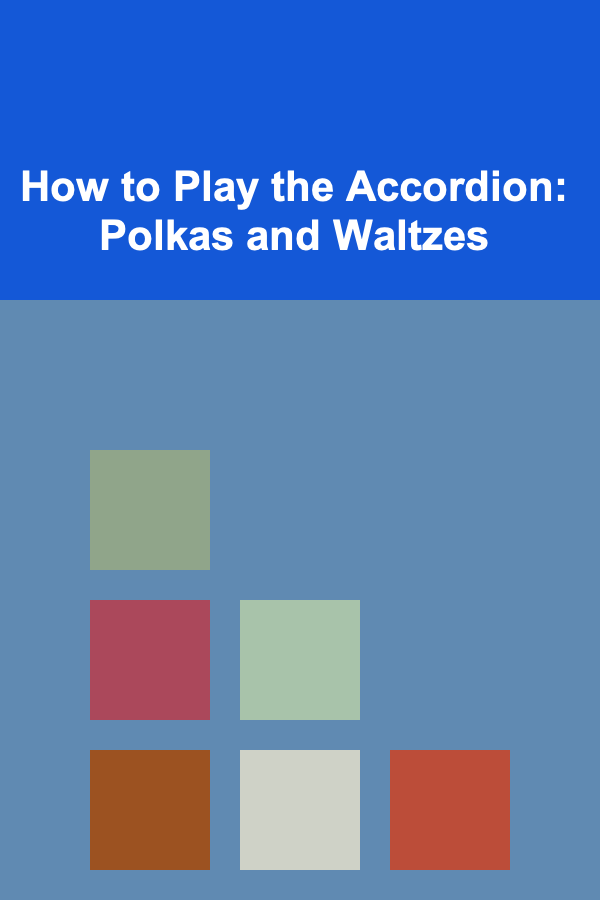
How to Play the Accordion: Polkas and Waltzes
ebook include PDF & Audio bundle (Micro Guide)
$12.99$5.99
Limited Time Offer! Order within the next:

The accordion, a fascinating and versatile instrument, has become synonymous with various folk music traditions around the world, from the vibrant sounds of French musette to the lively rhythms of Polkas and Waltzes in Central and Eastern European cultures. Learning to play the accordion is an exciting journey, offering a rich understanding of both melody and harmony in music. In this article, we will focus on how to master the art of playing Polkas and Waltzes on the accordion, delving into the essential techniques, rhythms, and tips that will help you become a proficient accordion player.
Understanding the Accordion
Before diving into the specific genres like Polkas and Waltzes, it's essential to understand the accordion itself. The accordion is a free-reed instrument, meaning that sound is produced when air passes over reeds within the instrument. It consists of two main parts: the keyboard on the right-hand side (for playing melodies) and the bass buttons on the left-hand side (for playing harmonies and bass lines).
Types of Accordions
There are several types of accordions, including diatonic and chromatic.
- Diatonic accordions are often used in folk and traditional music. They typically have fewer buttons than chromatic accordions and are tuned to specific keys.
- Chromatic accordions offer a full range of notes, allowing players to play in any key. These are often favored by musicians who perform in various genres, including classical, jazz, and popular music.
Both types of accordions can be used to play Polkas and Waltzes, but diatonic accordions are particularly associated with folk and traditional music, making them an excellent choice for playing these styles.
Getting Started with the Basics
Before jumping into the complexities of Polkas and Waltzes, you need to become familiar with the basics of playing the accordion. Here's what you need to know:
1. Learning the Hand Positions
On the accordion, proper hand positioning is crucial for playing efficiently and avoiding injury.
- Right Hand (Melody Side): Your right hand will primarily be used for playing the melody on the keyboard. Position your fingers on the white and black keys, keeping your wrist relaxed and your fingers curved slightly.
- Left Hand (Bass Side): The left hand plays the bass buttons. These buttons are grouped into a pattern similar to the keyboard, with one row for bass notes and another for chords. Place your hand so that each finger can comfortably reach the buttons.
2. Understanding the Bellows
The accordion produces sound when the bellows (the central part of the instrument) are compressed or expanded. Mastering control over the bellows is essential for creating dynamic sounds. Practice opening and closing the bellows smoothly while maintaining consistent air pressure.
- Push and Pull: Playing the accordion involves both pushing and pulling the bellows. When you push the bellows, air flows in one direction, producing a specific note; when you pull them, the air flows in the opposite direction, producing a different set of notes.
- Timing and Coordination: Coordination between your hands and the bellows is essential. While your right hand plays the melody, your left hand controls the bass and chord buttons. The bellows must be managed continuously to ensure a consistent sound and rhythm.
3. Learning Basic Chords and Bass Patterns
On the left-hand side of the accordion, the bass buttons provide both bass notes and chords. The most common bass patterns for beginners are:
- Single Note Bass: These are individual bass notes you play with your left hand. They provide a foundation for the melody.
- Chordal Bass: These are combinations of notes played together, producing a harmonic sound that accompanies the melody.
For Polkas and Waltzes, the bass patterns will be essential in providing rhythm and structure to the music.
Polkas and Waltzes: The Rhythms and Styles
1. The Polka Rhythm
The Polka is a lively, fast-paced dance originating from Bohemia (now part of the Czech Republic) and spreading throughout Europe and beyond. It's characterized by a 2/4 time signature and a strong, upbeat rhythm. The basic rhythm pattern for Polkas involves alternating between a bass note and a chord on the left-hand side of the accordion, while the right hand plays the melody.
Polka Bass Patterns
In Polka, the bass buttons are often played in a regular pattern that matches the 2/4 time signature. One common bass pattern for Polka is:
- Bass - Chord (played in a regular, repetitive rhythm: Bass, chord, bass, chord).
The Polka rhythm has a distinctive "oom-pah" feel, where the bass note (the "oom") is followed by a chord (the "pah").
2. The Waltz Rhythm
In contrast to the fast-paced Polka, the Waltz is slower, with a 3/4 time signature. The Waltz rhythm is much smoother and flowing, and it's often associated with graceful, ballroom-style dancing. The left-hand bass pattern for a Waltz generally consists of three beats per measure, which correspond to the 3/4 time signature.
Waltz Bass Patterns
For the Waltz, you'll typically play:
- Bass - Chord - Chord (one bass note on the first beat, followed by two chords on beats two and three).
This bass pattern, with its strong first beat, gives the Waltz its signature smooth and swaying feel.
3. Differences in Playing Polkas vs. Waltzes
While both Polkas and Waltzes involve a steady rhythm and coordination between the hands, the primary difference lies in the time signature and the feel of the music.
- Polkas are fast, energetic, and emphasize the first and second beats of each measure, creating a driving, lively sound.
- Waltzes, on the other hand, have a slower tempo and emphasize the first beat of each measure, which gives the music a more flowing, lyrical feel.
4. Adapting the Right-Hand Melody
When learning Polkas and Waltzes on the accordion, the right-hand melody plays a vital role in shaping the character of each style.
-
In Polkas, the melody is typically bouncy and syncopated, with a rhythmic pattern that matches the fast-paced energy of the music. You'll often find short, upbeat phrases that reflect the lively nature of the dance.
-
In Waltzes, the melody tends to be more lyrical and smooth, matching the flowing 3/4 time. The notes are often longer, with more sustained phrases and less percussive attack than in Polkas.
Practical Tips for Playing Polkas and Waltzes
1. Practice with a Metronome
To master the rhythms of Polkas and Waltzes, use a metronome to keep time. Start slow and gradually increase the tempo as you become more comfortable with the rhythms.
2. Focus on Your Bellows Technique
Your control over the bellows will significantly affect the quality of your playing. Practice expanding and contracting the bellows smoothly, ensuring a consistent and even sound. In Polkas, the bellows will often be used more aggressively to match the fast tempo, while in Waltzes, you'll want to maintain a more flowing and controlled motion.
3. Work on Hand Independence
The accordion requires a high degree of hand independence, as each hand performs different functions. Your right hand will focus on the melody, while your left hand plays bass notes and chords. Practice each hand separately before combining them to ensure smooth coordination.
4. Mastering the Left-Hand Bass Patterns
For both Polkas and Waltzes, the left-hand bass patterns are crucial for maintaining the rhythm. Start by practicing simple bass and chord progressions. Once you feel confident, try playing along with recordings of Polkas and Waltzes to get a better sense of how your bass patterns fit into the overall rhythm.
5. Explore Different Articulations
Both Polkas and Waltzes can benefit from varied articulations in the right-hand melody. Use staccato (short, detached notes) for a bouncy Polka feel and legato (smooth, connected notes) for the flowing melody of a Waltz. These subtle changes will add depth and expression to your performance.
6. Play Along with Others
The best way to improve your skills is to play with other musicians. Find a group of accordionists or join a folk band that focuses on Polkas and Waltzes. Playing with others will help you refine your timing, rhythm, and technique.
Conclusion
Learning to play Polkas and Waltzes on the accordion is both a rewarding and challenging experience. By mastering the basics of accordion playing, understanding the unique rhythms and styles of these dances, and focusing on hand coordination, bellows control, and melodic phrasing, you can develop a deep proficiency in this traditional instrument. With practice, you'll be able to add your own unique interpretation to Polkas and Waltzes, bringing the rich history of these dances to life through the expressive sound of the accordion.

How to Create a Master Document List for Your Home or Office
Read More
How to Invest in Mutual Funds: A Beginner's Guide
Read More
How to Make Your Own Statement Light Fixtures on a Budget
Read More
How to Set Financial Goals to Guide Your Investment Decisions
Read More
How To Grasp the Concepts of V2L (Vehicle-to-Load)
Read More
How to Build an Event Planning Checklist for Intimate Gatherings
Read MoreOther Products

How to Create a Master Document List for Your Home or Office
Read More
How to Invest in Mutual Funds: A Beginner's Guide
Read More
How to Make Your Own Statement Light Fixtures on a Budget
Read More
How to Set Financial Goals to Guide Your Investment Decisions
Read More
How To Grasp the Concepts of V2L (Vehicle-to-Load)
Read More